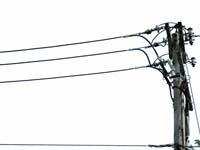Adaptations of wind and sun to the net

The electric supply is perfectly controlled. The network managers calculate daily the electricity needs the next day, the amount of electricity generated by each installation, the time and the operating time of each one, etc. Since electricity is not accumulated free of charge in the supply network, they must generate the electricity needed to meet the existing demand at any time. Neither more nor less.
Before the incorporation of wind and photovoltaic energy into the electric grid, the only one that prevented the prior determination of this control was consumption, since the consumption forecasts made on the eve can only be determined up to a certain measure.
The introduction of these two sources of electricity has had to be accompanied by another variable, since the generation of electricity has also become variable. This is one of the distinctive characteristics of wind and photovoltaic energy: they are very random. That is, electricity is generated when there is wind and sunlight, not when there is need for electricity.
Between them, the wind is the one that does the least with the demand: "In the anticyclonic days, that is, when there is no wind, the electrical demand is greater, both in winter and in summer, when it is when the coldest and heat is done," says Jon Andoni Barrena, professor of the electronics department of Mondragon Unibertsitatea. And wind energy is, beyond hydroelectric power, the renewable one that has advanced most in the Basque Country.
The network, in addition to being a random electrical source, being included in the special regime -- because it is electricity from renewable sources -- absorbs all the electricity from these sources. This obliges to adapt the generation of the rest of electricity sources to both.

The more electricity produced from wind turbines and solar panels, the more imbalances the supply network managers will have to face. On the one hand, they will have to have more and more energy in the reserve to be able to cope with electrical demand in the absence of wind or solar energy. On the other hand, at a given time, electric consumption can generate more electricity than is necessary. This would be a very serious problem, as it would increase the voltage of the network in excess.
Therefore, the electrical demand that can be met by these routes is limited. Juan Carlos Amasorrain, Barrena's companion, has set this limit by 40%. If they responded to a higher demand, it would be very difficult to balance fluctuations with the rest of electrical sources.
Most of the solutions to accumulate them
Thus, it seems beneficial to the environment but harmful to the electric grid. And that's not either, since measures can be taken to turn the situation around. Barrena and Amasorrain have explained the arrangements made in the network and what they hope to do in the future.
A solution would be to regulate the electricity generated by these two ways and depending on the demand. According to Barrena and Amasorrain, this is not a consequence of a technical inability: "There are electronic tools that could be used for this, for example, to supply half of the power that is being supplied in an turbine." Today, however, it is not done so, because they are legally authorized to sell on the net all the electricity they generate. "It's not logical to sell 60 when you can sell 100," Barrena said.

Another solution would be to accumulate electricity when more than is generated, when less than enough is produced. Currently, the most used technique for electrical storage is that of hydraulic pumping systems, hydroelectric power plants with two connected reservoirs. Thus, when more than enough is generated in wind or photovoltaic power plants, this excess of electricity is used to pump water from one reservoir to another of these systems. In the Iberian peninsula more than 15 gw of water can be generated accumulated in this type of systems.
In these cases, electricity is not accumulated properly, but the resource that generates it. However, electric storage batteries are also being developed for the supply network. According to Barrena, it is developing mainly in Japan and the United States.
He explains that the situation here is very different: "There is still no such system here, but in a period of about ten years, I think we started to see." In fact, both researchers have warned that the hydraulic power storage systems currently in existence do not allow much more energy to be stored, and that forecasts suggest that wind and photovoltaic energy will continue to increase.
There is still a renewable energy that has been diffused very little and that makes certain storage without need of batteries, such as photothermal energy or thermal solar energy. In these systems, by means of a set of mirrors (called heliostats) that collect solar energy at a given point, they use all this energy to convert sodium salts containing in a circuit into liquid. The accumulated energy of salts in liquid state is used to evaporate water and electricity is generated by passing the steam through turbines.
The theme of electric storage has led Barrena to a reflection: "If accumulation increases, in the end the concept of electric grid changes: now, inevitably, what is consumed and what is produced, but at the time when we introduce the possibility of accumulation, we can accumulate as we generate it and when demand rises we can use the accumulated to respond to demand."

Need to guarantee the quality of electricity
Amasorrain and Barrena have also mentioned the need to ensure the quality of electricity. In fact, the electricity moving in the electric grid must have a minimum quality: the flow must be as constant as possible, the voltage must be between certain intervals, etc.
Because the electricity generated through the wind turbines and solar panels is so fluctuating, sometimes more electricity is produced than is being consumed in certain areas. The introduction of this excess of electricity in the network would mean an increase in voltage in the network. In this situation, emerging devices are disconnected.
In order for the solution not to be disconnection, electronic control and power change systems have been developed and new systems are being developed. They are called power electronics systems. Barrena and Amasorrain mention two devices of this type: FACTS (AC flexible transmission systems) and custom power. The first ones are used in the electricity transport network to regulate power flows, that is, to control the flow changes.
The seconds are incorporated into the distribution network. They are used in wind and photovoltaic power plants to improve the quality of electricity: regulation of voltage levels, improvement of efficiency, etc.

In addition to the network, these devices can be used by private users to ensure the quality of the electricity they receive. Amasorrain clarifies it with an example: "Let's assume a company that makes aluminum foil. For the manufacture of this paper we pass a large aluminum bushing for several rollers, finally obtaining long papers of a few microns of thickness that we collect in rolls. If the electrical grid is interrupted at a time, or if the amount of electricity decreases at any given time, even at a very short time, the entire system is destabilized and the work of several hours is dissolved. As custom power avoid it because they eliminate the possible shortages".
There are, therefore, technical means to avoid or solve the problems arising from the integration of wind and photovoltaic energies into the current network, and to maintain the quality of the network. However, the degree of use is another aspect, since the authorities will determine the progress of the different renewable energy sources based on economic and political reasons beyond technological resources.





